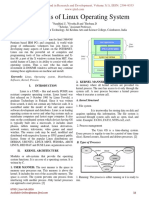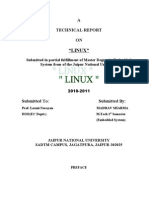0% found this document useful (0 votes)
6 views29 pagesLinux
The seminar report on Linux Kernel 3.6, presented by Satyajit Sethy, outlines significant advancements in the kernel released in September 2012, including TCP Fast Open for reduced latency, improved file system support, and enhanced power management features. The report details the kernel's evolution, its modular nature, and the collaborative development model that has contributed to its widespread adoption across various computing environments. Key highlights include improvements in security, networking capabilities, and hybrid sleep support, making Linux Kernel 3.6 a pivotal release in the operating system's history.
Uploaded by
sachinmaharana018Copyright
© © All Rights Reserved
We take content rights seriously. If you suspect this is your content, claim it here.
Available Formats
Download as PDF, TXT or read online on Scribd
0% found this document useful (0 votes)
6 views29 pagesLinux
The seminar report on Linux Kernel 3.6, presented by Satyajit Sethy, outlines significant advancements in the kernel released in September 2012, including TCP Fast Open for reduced latency, improved file system support, and enhanced power management features. The report details the kernel's evolution, its modular nature, and the collaborative development model that has contributed to its widespread adoption across various computing environments. Key highlights include improvements in security, networking capabilities, and hybrid sleep support, making Linux Kernel 3.6 a pivotal release in the operating system's history.
Uploaded by
sachinmaharana018Copyright
© © All Rights Reserved
We take content rights seriously. If you suspect this is your content, claim it here.
Available Formats
Download as PDF, TXT or read online on Scribd
/ 29




























































































